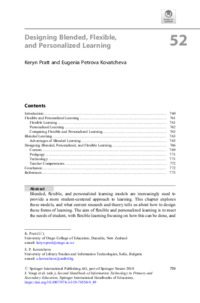Designing Blended, Flexible, and Personalized LearningKeryn Pratt, Eugenia Kovatcheva
Zu finden in: Second Handbook of Information Technology in Primary and Secondary Education (Seite 759 bis 776), 2018
  |
 |
 Diese Seite wurde seit 3 Jahren inhaltlich nicht mehr aktualisiert.
Unter Umständen ist sie nicht mehr aktuell.
Diese Seite wurde seit 3 Jahren inhaltlich nicht mehr aktualisiert.
Unter Umständen ist sie nicht mehr aktuell.
 Zusammenfassungen
Zusammenfassungen
 Blended, flexible, and personalized learning models are increasingly used to provide a more student-centered approach to learning. This chapter explores these models, and what current research and theory tells us about how to design these forms of learning. The aim of flexible and personalized learning is to meet the needs of student, with flexible learning focusing on how this can be done, and personalized learning on the outcomes. A common approach to implementing either flexible or personalized learning has been to use blended learning; that is, learning that occurs both online and in-person. There are many different ways in which blended learning can be implemented, with an expectation that this will continue to expand as new technologies become available. This variation in the way blended learning can be operationalized make creating universal design principles difficult. Current approaches to designing blended learning aimed at delivering flexible or personalized learning largely draw on descriptive studies of blended learning, or on theories and lessons drawn from the online and face-to-face fields. It is also common for design principles to have come from the higher education literature, where more research on the use of blended learning exists. In designing for blended learning, both the physical and online environments need considered, as do the context in which teaching and learning is to occur, the desired pedagogical approach, and what technology is available. A critical part of the design process is to ensure that learning drives the use of technology, rather than the reverse. It seems likely that blended learning will continue be used to deliver flexible and personalized learning and more investigation into how blended learning can effectively deliver flexible and personalized learning in primary and secondary schools is needed.
Blended, flexible, and personalized learning models are increasingly used to provide a more student-centered approach to learning. This chapter explores these models, and what current research and theory tells us about how to design these forms of learning. The aim of flexible and personalized learning is to meet the needs of student, with flexible learning focusing on how this can be done, and personalized learning on the outcomes. A common approach to implementing either flexible or personalized learning has been to use blended learning; that is, learning that occurs both online and in-person. There are many different ways in which blended learning can be implemented, with an expectation that this will continue to expand as new technologies become available. This variation in the way blended learning can be operationalized make creating universal design principles difficult. Current approaches to designing blended learning aimed at delivering flexible or personalized learning largely draw on descriptive studies of blended learning, or on theories and lessons drawn from the online and face-to-face fields. It is also common for design principles to have come from the higher education literature, where more research on the use of blended learning exists. In designing for blended learning, both the physical and online environments need considered, as do the context in which teaching and learning is to occur, the desired pedagogical approach, and what technology is available. A critical part of the design process is to ensure that learning drives the use of technology, rather than the reverse. It seems likely that blended learning will continue be used to deliver flexible and personalized learning and more investigation into how blended learning can effectively deliver flexible and personalized learning in primary and secondary schools is needed. Dieses Kapitel erwähnt ...
Dieses Kapitel erwähnt ...
 Personen KB IB clear | D. Randy Garrison , Ruben R. Puentedura , Norman D. Vaughan | ||||||||||||||||||
 Begriffe KB IB clear | Blended LearningBlended Learning
,  Lernen Lernen learning
, learning
,  SAMR-Model SAMR-Model
| ||||||||||||||||||
 Bücher |
| ||||||||||||||||||
 Texte |
|
 Zitationsgraph
Zitationsgraph
 Zitationsgraph (Beta-Test mit vis.js)
Zitationsgraph (Beta-Test mit vis.js)
 Anderswo finden
Anderswo finden
 Volltext dieses Dokuments
Volltext dieses Dokuments
 |  Designing Blended, Flexible, and Personalized Learning: Artikel als Volltext bei Springerlink ( Designing Blended, Flexible, and Personalized Learning: Artikel als Volltext bei Springerlink ( : :  , 291 kByte; , 291 kByte;  : :  ) ) |
 Anderswo suchen
Anderswo suchen 
 Beat und dieses Kapitel
Beat und dieses Kapitel
Beat hat Dieses Kapitel während seiner Zeit am Institut für Medien und Schule (IMS) ins Biblionetz aufgenommen. Beat besitzt kein physisches, aber ein digitales Exemplar. Eine digitale Version ist auf dem Internet verfügbar (s.o.). Aufgrund der wenigen Einträge im Biblionetz scheint er es nicht wirklich gelesen zu haben. Es gibt bisher auch nur wenige Objekte im Biblionetz, die dieses Werk zitieren.










 Biblionetz-History
Biblionetz-History